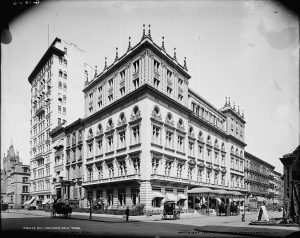New York City began to see its first few restaurants in the middle of the 18th century, which led to numerous oyster houses and cellars popping up all over the Big Apple, with their numbers increasing tenfold in mere decades. The cultural theme of eating in city restaurants began to catch on, effectively changing how, where, and why we eat altogether.

Delmonico’s 1930
Delmonico’s is perhaps one of the most well known restaurants in New York City, and its influence on the town’s food scene has been enormous. Today, it is a premiere 5-star restaurant catering to the wealthy. However, its history is much more humble.
Opening in 1827, the idea of Delmonico’s began with two Swiss brothers wanting to open a French pastry cafe. Four years later, they were a booming restaurant that demanded expansion into what is now Delmonico’s full size. A French restaurant was a cultural shift during this time, as their competitors were almost all focusing on British cuisine. This gave the restaurant a leg up in the city’s food scene, shaping what we now know today as fine dining.
High-end restaurants consisted of luxurious furnishings like marble columns, chandeliers, crystal glasses, and silver utensils. It created an expectation among patrons to be served with the finest amenities available, and with respect, thus spawning a higher class of restaurant etiquette. Today, there are thousands of restaurants that pride themselves on their exceptional service, and strive for 5-star rating. But, it is just as important to look at the history of New York City’s smaller scale restaurants if we are to gain more of an appreciation for the diversity this town’s food scene has to offer.
Diners and fast-food restaurants can trace their roots back to New York City’s quick-serve houses that originally catered to the all-male employees working along Wall Street and Broadway. These were developed to allow workers to say close to their places of work rather than having to go home for a midday meal. Understanding the time limits they had and the amount of men in these given areas, these restaurants were known to serve smaller meals at a faster rate, with seating to accommodate large quantities of people; what we can refer to today as booths.
At the moment, New York City has over 45,000 food and beverage locations, and that number is sure to grow in the coming years. With how influential certain businesses have been in the city’s food scene, we are bound to see further innovation that may pave the way for even more breakthroughs in the restaurant industry.

